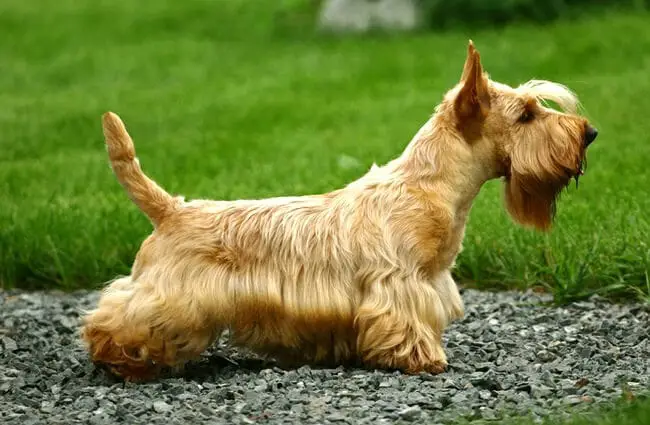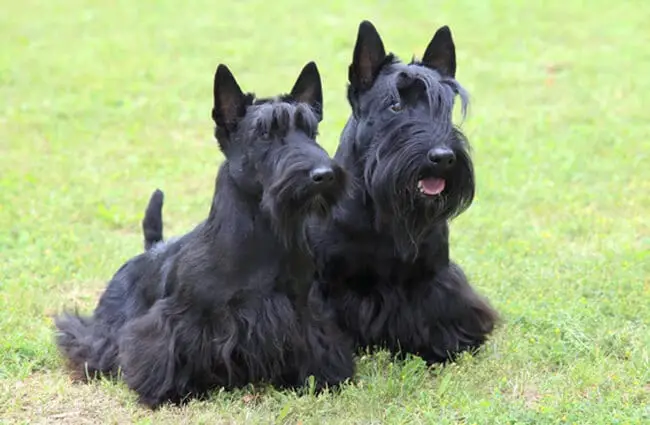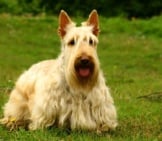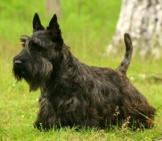The Scottish terrier, better known as the “Scottie,” is well-loved, and considered the modern hallmark of, Britain’s terrier breeds. Originally bred in the 1800s in Scotland for hunting rats, badgers, and even foxes, the Scottie remains true to its hunting characteristics.
Most commonly displayed when encountering local rabbit, fowl, and even your neighbor’s cats. The Scottie is well-known for being independent and confident, making for a dignified and bold companion. Read on to learn more about the Scottish terrier.
Description of the Scottish Terrier
The Scottie is a compact, short-legged terrier with a distinctive coat that is lengthened at the beard, eyebrows, legs, and lower body. This unique-looking coat, coupled with an erect tail and ears, conveys the Scottie’s propensity for alertness. The Scottie is often described as aloof toward strangers, making them excellent watchdogs.
The Scottish terrier’s coat can be black, wheaten yellow, or a brindled pattern. This breed has a hard, wiry, weather-resistant outer coat and a dense undercoat, allowing them to tolerate cold and hot weather fairly well.
Life Expectancy and Size
The Scottish terrier has a life expectancy of approximately 11-13 years, which can be effected by breeding practices, diet, and exercise. The Scottie stands 10 inches tall at the shoulder, and weighs a mere 18-22 pounds.
Scottish terriers are known for being generally healthy but, like all purebred dogs, are prone to certain conditions and diseases. The breed is known for “Scottie cramp,” which can cause the dog to be overstimulated or stressed. He may arch his back, over-flex his legs, and may show a gait much like goose-stepping. Scottie cramp is generally harmless, but in some cases the dog may temporarily lose its ability to run or walk.
Other issues generally appear during growing stages of the puppy, where skull bones can become irregularly enlarged, affecting chewing, and he may have issues with patella luxation. Treatments for these issues are generally surgery and lifestyle changes.
Protective Ability
Scottish terriers are known for their watchdog-type tendencies. While they may not be intimidating in appearance, the Scottie will alert the owner of intruders, and oftentimes passersby. Right behind German shepherds and Rottweilers, the Scottie ranks third in alarm barking, so if this suits your need and lifestyle, the Scottish terrier will make an unwanted visitor think twice.
Keep in mind that this can be especially problematic in apartment-style living, as well as in homes with close property lines. Needless to say, proper training and positive reinforcement can help reduce this tendency, however any owner looking to add a Scottie to the family should prepare for diligent training.
Training
Scottish terriers can be especially sensitive to harsh training techniques. The breed is best taught with positive, reward-based, reinforcement. The Scottish terrier thrives on frequent, brisk walks, but should not be used as a jogging partner. Their short legs do not bode well for long-distance marathons, but they will happily keep up for multiple walks a day.
The Scottie needs ample mental stimulation as well, as they are highly driven and need to channel that energy in a positive way. If not stimulated, you may find the Scottie attempting a landscaping job, creating a couple of extra holes in the backyard.
Energy Level
The Scottish terrier benefits from at least two walks a day to stimulate him mentally and physically. The Scottish terrier was bred for hunting, and physically designed to dig, so finding positive outlets to this ample energy is key to coexisting peacefully with this breed.
What Living with a Scottish Terrier is Like
Given the size of the Scottish terrier, the breed is highly adaptable to various lifestyles, whether apartment, ranch, small home, and more. Keeping in mind that the Scottish terrier breed ranks third in alarm barking, training and stimulation is extremely important. Ideally, the Scottie has ample space to roam, as well as a physical fenced yard because the breed has a high prey drive, and will happily escape an electric fence to chase the neighbor’s cat.
The Scottie is not ideal for households with young children or infants, because the breed is known to react and defend against unwanted poking, prodding and pulling. With well-behaved children, this can be mitigated, and the Scottie will appoint themselves the guardian of your little ones.
It is extremely important that the young Scottish terrier be socialized with dogs, people, and animals of all sizes, and rewarded for positive interactions. The Scottish terrier is known for being aloof with strangers, and protective when facing other dogs, so early socialization and introductions are necessary to prevent behavioral issues when the dog ages.
Care of the Scottish Terrier
Generally speaking, the Scottish terrier adapts well to most dwellings, given their small stature. Proper exercise, training, and diet will allow them to fit happily into your lifestyle.
Environmental Needs
The Scottie does well in most climates and is very adaptable. The Scottish terrier should never be left unsupervised around water deeper than their body. The Scottish terrier has been known to drown easily due to his short legs and heavy body, so never leave a pool or hot tub uncovered.
Exercise Needs
The Scottish terrier excels in high energy environments, but is not suited for swimming or agility courses, given their short legs and heavy body. The Scottie was built for digging and a high prey drive, so having a designated digging spot, and keeping your dog on leash when outside of the safe confines of the home, are especially important. The Scottish terrier will see and chase a squirrel happily, but a car in the street can be an unfortunate oversight.
Shedding and Grooming
The Scottie’s hair continues to grow, meaning shedding is less frequent than most short haired breeds. The Scottish terrier’s skin does easily dry out causing irritation and discomfort, so do not bathe him unnecessarily. The breed does require significant and frequent grooming, at least once weekly. If you are preparing a show dog, grooming increases to daily to maintain a picture-perfect coat and style.
The Scottie needs to be trimmed every two months or so, or several times per year. Keep in mind that frequent trimming can result in the appearance of a lackluster but softer coat. While this may not be the breed standard, it will depend entirely on personal preference and how frequently you wish to groom the puppy!
Ideal Home Environment
The Scottish terrier tends to be popular with the older generation, but can be great at any age if they are given daily walks. As long as you do not expect a marathon runner, the Scottie can be a great fit for your family. Remember, the Scottish terrier has watchdog tendencies, so if you don’t mind the barking, then they can adjust to your family’s lifestyle well.
Remember, with short legs and heavy body, they are not suited for homes with open pools, as it can be life threatening if they fall in and get stuck.
Health Concerns
The breed is generally healthy, though falls prey to certain diseases and growth issues if poorly bred. Also, diet and exercise are necessary to keep the breed healthy, and ensure a long life, so do not overfeed or fall prey to begging eyes for extra treats!
Find a reputable breeder who shows proof of genetic testing and can put you in contact with happy customers who have not had issues with their puppies.
Behavior Problems
Scottish terriers were bred for hunting and have a high prey drive, so if you have a cat in the residence, early socialization is key. Keep in mind that the Scottie will happily take off after small prey, as it is entirely instinctual to their breed. Scottish terriers can also be wary around strangers, so proper introductions are key, whether to new people or new dogs.
Scottish terriers are also not well suited for homes with small rodents or mammals, such as hamsters, guinea pigs, or mice. Scotties will instinctively kick in their prey drive, so avoid these pairings.
























![Red Angus Closeup of a beautiful Red Angus cowPhoto by: U.S. Department of Agriculture [pubic domain]https://creativecommons.org/licenses/by/2.0/](https://animals.net/wp-content/uploads/2020/03/Red-Angus-4-100x75.jpg)

